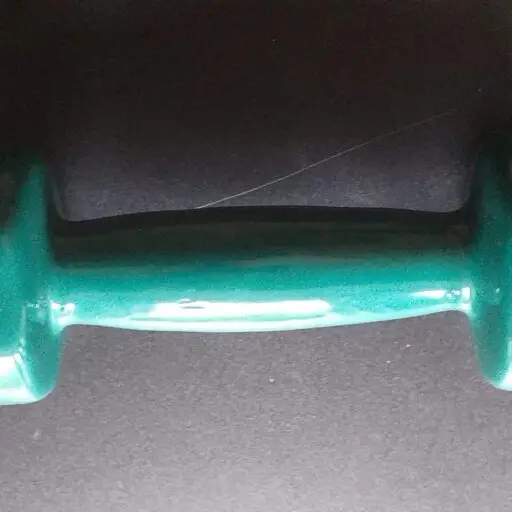All about the Narrow Grip Pull-down
(Back)

BENEFITS & MUSCLES WORKED: Lats (thickness), Middle and Lower Traps, Rhomboids
START POSITION: Sit down beneath a cable machine after already attaching your chosen type of bar. Adjust the machine weight to match your ability. Then, grab the bar as shown and sit down, allowing your body weight to assist you in pulling the bar down as you sit. Follow through as you sit down to pull the bar to the top of your chest, keeping your chin up and looking straight forward. Secure your thighs so that they do not lift as the bar goes up.
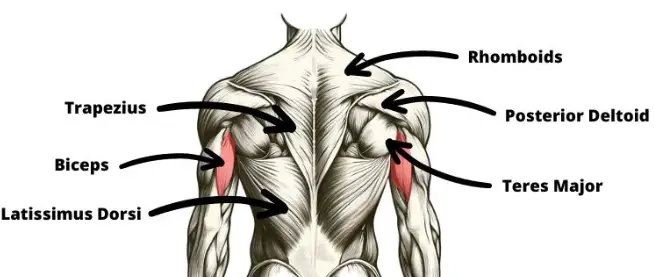
NOTES: Difficulty Rating: 54%
Start with just one practice rep and use it to make minor adjustments to the position of your grip, legs, feet, and buttocks. Your legs, arms, and shoulders must do all the work. No legs. Think zero legs. Plant them.
You can reduce stress on your shoulders by gradually tilting your head upward as the bar moves upward, and then slowly tilting your head back to the starting position. Try to follow the centre of the bar with your eyes.
Let the bar pull back up slowly and steadily. If the weights crash down loudly at the top position, then you probably need to adjust the seat height to be lower. If the weights crash at the lower position, then try raising the seat level. No jerking movements – keep it flowing smoothly and at a moderate pace. If you are big and tall, it may be that this machine is not suitable for someone of your size. I advise against using this type of equipment, as it will restrict your Range Of Motion (ROM). This leads to terrible FORM, and the Mojoh Method is all about STRIVING FOR PERFECT FORM. Breathe in as you go up, and out as you go down. It helps get a good stretch on the back muscles if you let the weight give your arms a little stretch at the top position, but to do this safely, note that your legs must be firmly secured (like in the photo).
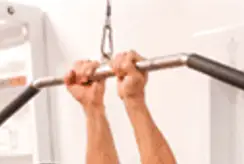
It’s not difficult for me to classify this exercise as one of the most essential exercises that anyone can do. If I were only allowed to do one gym exercise for the rest of my life, then it would be something like this one. There is a strong correlation between PULL-UPS and PULL-DOWNS, because they essentially work precisely the same muscles (mostly BACK). PULLUPS (and PULLDOWNS) work multiple muscle groups at once, including BACK, ARMS, and SHOULDERS. They are also a great way to build FUNCTIONAL STRENGTH and overall body CONTROL and COORDINATION.
If you are lucky enough to have an ‘Assisted Pull-ups’ machine in your gym, then this is the best option to choose. Few people are strong enough to pull up their bodyweight using a solid bar suspended way above their head (these are bodyweight PULLUPS). The assisted pull-up machine typically features an adjustable ‘plate’ or platform that allows you to kneel or stand, depending on the exercise being performed. Or you can fold away the plate and switch to ‘bodyweight exercises’. Bodyweight exercises are simply those that involve lifting or pulling using the weight of your own body, rather than using isolated dumbbell exercises or machines with cables, pullies, and adjustable weights. This type of exercise is also known as calisthenics. I am a strong advocate of this modern training approach.
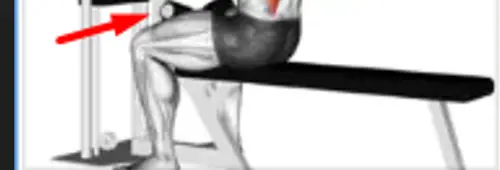
So, however you decide to do your pull-ups (overhead bar) or pull-downs (Cable and pulley machine), the next thing to learn is the different types of handgrips and what they mean.
Firstly, you should be familiar with underhand, overhand, and neutral grips. These types can be mixed to engage and work different muscle groups of the back, arms, and shoulders. But for the Mojoh Method, I use and teach only the fundamental grip/bar/arm combinations:
UNDERHAND GRIP Chiefly used for Close Grip and Narrow Grip Pull-downs/Pull-ups. Also known as the Supinated Grip. (see image)
Neutral Grip: This requires a special V-shaped accessory, known as a V-Bar, which is attached to a cable machine using a Carabiner clip (see image).

The Neutral Grip is the best grip to use for Narrow Grip pull-downs/pull-ups, as it provides the most concentrated muscle engagement while keeping unwanted stresses away from the shoulders, neck, and elbows. There’s also a wider bar attachment that is used for a wider Neutral grip. If you have access to this piece of equipment, then you should use it. A neutral grip is always best for people who have Shoulder issues or other physical limitations. However, if you are injury-free, then you should always ‘mix up’ all these grips and exercises, experiment, and don’t forget that whilst Narrow and Close Grip exercises are often easier, you still need to do the Wide Grips whenever possible (but usually less weight is required when using a Wide Grip). Remember to always tuck in your elbows when doing the Neutral Grip, as this promotes better engagement of your back muscles.
My best advice is to start with very low weights when experimenting with your hand grips to determine what feels best for your physique and fitness level. Build the weight gradually, and don’t be afraid to mix up the grips and exercises from time to time to reduce the risk of overuse injuries. This is because the action of repeatedly doing any exercise with the same movements and only a slight form imperfection will sooner or later result in a fairly severe overuse injury.
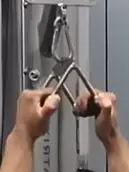
For example, runners who repeatedly run on flat, hard surfaces with poor form (this might even be where one leg is longer than the other) will eventually suffer from a Stress Fracture (usually around the shin area of the leg).
Pronated Grip (also known as Overhand Grip)
This is the standard grip used when grabbing a gym barbell to push up the bar above your head with Shoulder Presses, and for doing Upright Rows, where you lift the bar from hip level to chest level. It is the best grip (actually the only grip) to use for Wide Lat Pull-downs. Using a Supinated Grip for wide lat pull-downs can put a significant amount of stress on your wrists and other areas – avoid it. The Pronated Grip Wide Pull-down is probably the best lat exercise you can do anywhere. If you aim to get that classic tapering V shape to the shape of your Back, then you quite simply cannot skip this exercise! For most people, especially beginners, I recommend just doing a mix of 2 (max 3) types of pull-downs. Start with narrow supinated grip pull-downs, as these are an excellent warm-up exercise to engage the back, arms, and shoulders in a single compound movement. If time allows, also do some supinated close-grip exercises.

Then, after the close/narrow, switch to a pronated wide bar grip (overhand grip). I always do these first in my Back warm-up (but relatively light weights with high reps). After that, I perform exercises targeting the larger and medium back muscles, and lastly, I work on the smaller Back muscles with exercises like reverse flies and Hyperextensions.
Supinated Grip (also known as Underhand Grip, Reverse Grip)
For Close Pull-downs, you can use either a Pronated or Supinated Grip. Although a Neutral Grip is best for this exercise, if you have access to the right equipment. A simple change in hand grip can drastically influence the outcome and effect of pull-ups/pull-downs.

There is often confusion among people as to the different meanings of these various grips and positions. The most common confusion is made between the Close Grip and Narrow Grip. Let me clear up the confusion. The Narrow Grip is VERY narrow. The Close Grip is actually where the hands are gripping somewhere above the shoulders, usually slightly wider than the shoulders. This means that the hands are positioned closer to the shoulders than in the Wide Grip. The Narrow Grip refers to a position where the verticals of the arms are sloping inwards, thereby bringing the hands very close together. Confused? Don’t worry, most people are 🙂


